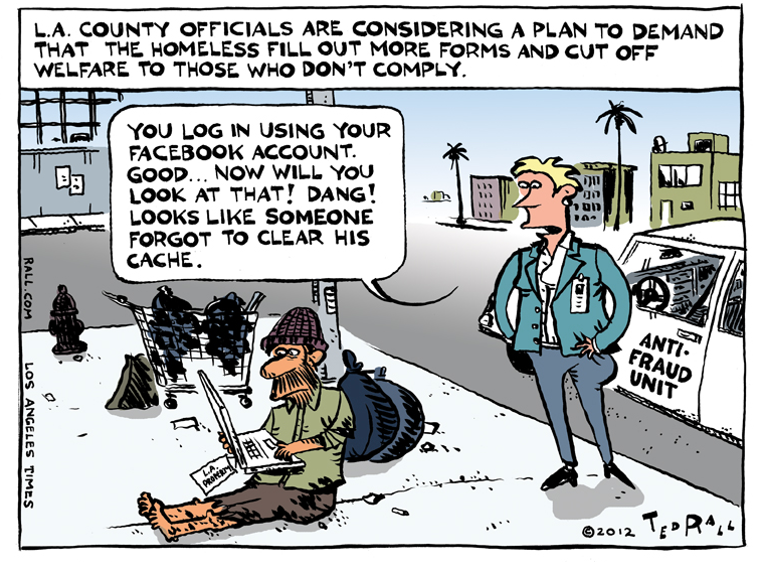CommentsPlanning Watch: In municipal politics it has become harder to distinguish real progressives from fauxgressives (market fundamentalists posing as progressives), especially over the hot button issue of homelessness.
A major reason is that the fauxgressives have learned how to convey concern for the homeless while advancing the wish list of real estate speculators. Recent examples are fauxgressive who support statewide up-zoning via Senate Bill 10 and local up-zoning through the Hollywood Community Plan's Implementation Ordinance (CPIO). This duplicity is necessary because Los Angeles is a liberal city where all political players, regardless of their hidden “business-friendly” agendas, publicly express concern about homelessness, equity, sustainability, and aggressive policing.
But since appearances are often deliberately deceiving, this field guide should help you spot the real progressives and uncover the imposters.
When it comes to the housing crisis, the fauxgressives, whether lobbyists, City Council candidates, or elected officials, scrupulously avoid saying the following. These systematic omissions are this Field Guide’s biggest reveal of the fauxgressive’s actual role:
Omission #1) Growing economic inequality and poverty are major drivers of homelessness. Throughout the entire United States, but especially in coastal cities like Los Angeles, economic inequality has priced out an increasing number of people from housing. They are either unemployed or paid wages so low they cannot afford a place to live, even though Los Angeles has thousands of vacant residences.
Omission #2) Restoring CRA and HUD public housing programs, nearly all of which have been continually defunded beginning in the Nixon administration.
Omission #3) Ending local density bonus programs since they play a major role in the loss of affordable housing. These include LA’s barely legal Transit Oriented Community Guidelines (TOC) and other forms of residential up-zoning, such as the draft Hollywood Community Plan’s Implementation Ordinance (CPIO).
Omission #4) Strengthening the State of California’s rent control laws and the City of LA's Rent Stabilization Ordinance. Vacancy decontrol should be removed, and the rent stabilization base year ought to be 2006, not 1978, to add thousands of apartments to the inventory.
Omission #5) Blocking investment funds from driving up the cost of housing by buying houses and apartments and then keeping some of them off the market.
Omission #6) Requiring LA’s Department of Housing and Community Investment (HCID) to create and maintain easily accessible registries of pledged density bonus housing and certified low-income tenants.
Omission #7) Directing LA’s HCID to physically inspect promised density bonus housing to verify that it exists, and is rented to vetted low income tenants.
Omission #8) Amending LA’s anti-mansionization ordinances to stop the demolition of older, lower-priced homes to make way for expensive McMansions.
Omission #9) Revising California’s Ellis Act to prevent the eviction of low-income tenants so developers can build expensive in-fill apartment buildings.
Given this list of nine pro-active housing programs that the fauxgressives shun, how do they convince the public that they are nevertheless concerned about homelessness? How do they skip over the causes of homelessness while shedding crocodile tears for the homeless? The answer is they offer grim statistics about LA's homeless crisis, and then propose local programs, without ever examining the structural causes and cures for the housing crisis.
- Less than 9 percent of LA’s population is Black, while 40 percent of the homeless are Black.
- Veterans make up 3.5 percent of LA’s population, but 6.5 percent of the unhoused population.
- In 2019 one-third of the LAPD’s use-of-force actions were against homeless people.
- More than 1000 thousand homeless people die on LA’s streets each year.
- According to HUD, only 16 percent of the apartments in Los Angeles are affordable and each year this percentage declines.
- 732 new permanent supportive housing units opened in 2019, and thousands more are expected soon, including 2,360 scheduled to open in the next 12 months, part of a total construction pipeline of 10,638 units.
- In Los Angeles, the median rent is 46.7%, which is nearly half of the median income.
- In 2020 homelessness rose 12.7 percent in Los Angeles County and now numbers 66,000 people.

After reciting these and similar statistics to demonstrate concern about homelessness in Los Angeles, the fauxgressives then suggest strictly local, non-structural housing initiatives:
- LA needs more homeless programs, including Project Roomkey, Project Homekey, Safe Camping, Safe Parking, and Drop-in Centers.
- If Los Angeles increased its permitted residential zoning capacity, developers would build more housing, and homelessness would decline or disappear.
- Tenants deserve a right to legal counsel to end illegal evictions.
- Laws that criminalize poverty and homelessness, such as anti-camping ordinances, should be repealed.
- Sweeps of homeless encampments that confiscate or destroy personal possessions must end.
- Tenants need an ordinance to shield them from landlord harassment.
- The LAPD should not be the go-to public agency for local residents’ complaints about homeless encampments.
To be clear, the facts documenting LA’s housing crisis are legitimate. Likewise, some local programs offer short-term relief, but others, especially up-zoning, make the housing crisis worse. As long as their solutions remain band-aids, and some of their proposals are giveaways to developers, the fauxgressives will be part of the problem, not part of the solution.
(Dick Platkin is a former Los Angeles city planner who reports on local planning issues for CityWatchLA. He serves on the board of United Neighborhoods for Los Angeles (UN4LA) and co-chairs the new Greater Fairfax Residents Association. Previous Planning Watch columns are available at the CityWatchLA archives. Please send questions and corrections to [email protected] .)














